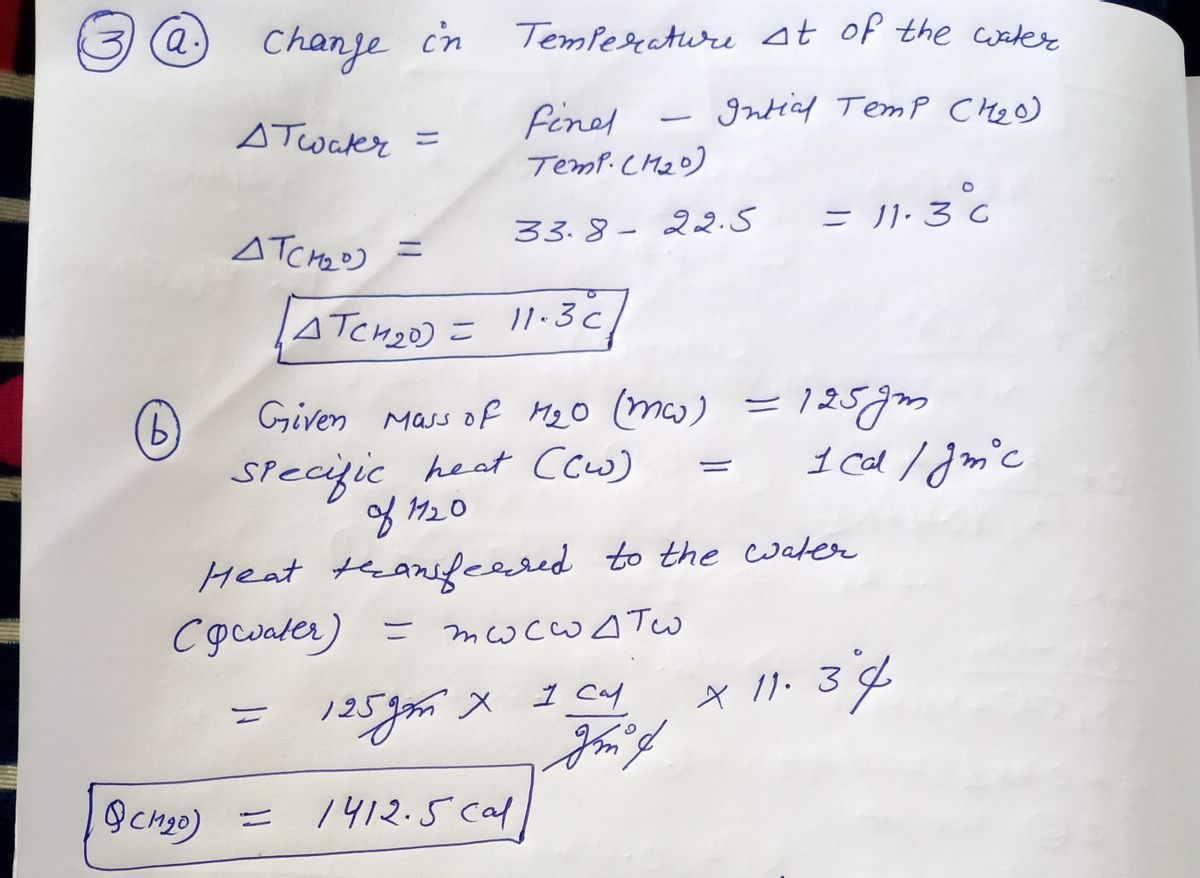3. A paraffin wax candle weighs 10.553 grams. The candle is lit and then immediately placed in a calorimeter that contains 125.0 g of water that is initially at 22.5 °C. After about 20 minutes of burning, the candle is extinguished and the final water temperature is 33.8 °C. The weight of the candle after burning is 9.871 grams. Assume that all of the energy that was in the burned paraffin wax is transferred to the water. a) Calculate the change in temperature (AT) of the water. b) Calculate the amount of energy that was released from the paraffin wax. Assume that all of the energy that was released from the paraffin was transferred to the water. Use the specific heat (S) of water (1.000 cal/g °C), the mass of the water that was in the flask, and the temperature change (AT) of the water to calculate the amount of energy (0) that was transferred to the water, and thus the amount of energy that was released from the burned paraffin wax. c) Calculate the mass of the paraffin wax that was burned. This is done by subtracting the mass of the candle remaining after burning from the original mass of the candle. d) Calculate the energy per gram of paraffin wax by dividing the energy that was released from the paraffin wax (from part b) by the mass of the paraffin that was burned (from part c).
3. A paraffin wax candle weighs 10.553 grams. The candle is lit and then immediately placed in a calorimeter that contains 125.0 g of water that is initially at 22.5 °C. After about 20 minutes of burning, the candle is extinguished and the final water temperature is 33.8 °C. The weight of the candle after burning is 9.871 grams. Assume that all of the energy that was in the burned paraffin wax is transferred to the water. a) Calculate the change in temperature (AT) of the water. b) Calculate the amount of energy that was released from the paraffin wax. Assume that all of the energy that was released from the paraffin was transferred to the water. Use the specific heat (S) of water (1.000 cal/g °C), the mass of the water that was in the flask, and the temperature change (AT) of the water to calculate the amount of energy (0) that was transferred to the water, and thus the amount of energy that was released from the burned paraffin wax. c) Calculate the mass of the paraffin wax that was burned. This is done by subtracting the mass of the candle remaining after burning from the original mass of the candle. d) Calculate the energy per gram of paraffin wax by dividing the energy that was released from the paraffin wax (from part b) by the mass of the paraffin that was burned (from part c).
Chemistry
10th Edition
ISBN:9781305957404
Author:Steven S. Zumdahl, Susan A. Zumdahl, Donald J. DeCoste
Publisher:Steven S. Zumdahl, Susan A. Zumdahl, Donald J. DeCoste
Chapter1: Chemical Foundations
Section: Chapter Questions
Problem 1RQ: Define and explain the differences between the following terms. a. law and theory b. theory and...
Related questions
Question
Will you help me, please?

Transcribed Image Text:**Experiment: Energy Transfer from Burning Paraffin Wax**
A paraffin wax candle with an initial weight of 10.553 grams is used. After lighting the candle, it is placed in a calorimeter with 125.0 grams of water at an initial temperature of 22.5°C. After 20 minutes of burning, the candle is extinguished, and the water temperature is observed to be 33.8°C. The final weight of the candle is noted as 9.871 grams. This experiment assumes that the energy from the burned wax is fully transferred to the water.
### Tasks:
**a) Calculate the change in temperature (\(\Delta T\)) of the water.**
**b) Calculate the energy released from the paraffin wax.**
- *Assumption*: All energy from the wax is transferred to the water.
- Use the specific heat (S) of water: \(1.000 \, \text{cal/g°C}\).
- Use the mass of the water, the specific heat, and the \(\Delta T\) to find the energy (Q).
**c) Calculate the mass of the paraffin wax that was burned.**
- This involves subtracting the final mass of the candle from its initial mass.
**d) Calculate the energy per gram of paraffin wax.**
- This is done by dividing the energy from part (b) by the mass of the paraffin burned (part c).
Expert Solution
Step 1

Step by step
Solved in 2 steps with 2 images

Knowledge Booster
Learn more about
Need a deep-dive on the concept behind this application? Look no further. Learn more about this topic, chemistry and related others by exploring similar questions and additional content below.Recommended textbooks for you

Chemistry
Chemistry
ISBN:
9781305957404
Author:
Steven S. Zumdahl, Susan A. Zumdahl, Donald J. DeCoste
Publisher:
Cengage Learning

Chemistry
Chemistry
ISBN:
9781259911156
Author:
Raymond Chang Dr., Jason Overby Professor
Publisher:
McGraw-Hill Education

Principles of Instrumental Analysis
Chemistry
ISBN:
9781305577213
Author:
Douglas A. Skoog, F. James Holler, Stanley R. Crouch
Publisher:
Cengage Learning

Chemistry
Chemistry
ISBN:
9781305957404
Author:
Steven S. Zumdahl, Susan A. Zumdahl, Donald J. DeCoste
Publisher:
Cengage Learning

Chemistry
Chemistry
ISBN:
9781259911156
Author:
Raymond Chang Dr., Jason Overby Professor
Publisher:
McGraw-Hill Education

Principles of Instrumental Analysis
Chemistry
ISBN:
9781305577213
Author:
Douglas A. Skoog, F. James Holler, Stanley R. Crouch
Publisher:
Cengage Learning

Organic Chemistry
Chemistry
ISBN:
9780078021558
Author:
Janice Gorzynski Smith Dr.
Publisher:
McGraw-Hill Education

Chemistry: Principles and Reactions
Chemistry
ISBN:
9781305079373
Author:
William L. Masterton, Cecile N. Hurley
Publisher:
Cengage Learning

Elementary Principles of Chemical Processes, Bind…
Chemistry
ISBN:
9781118431221
Author:
Richard M. Felder, Ronald W. Rousseau, Lisa G. Bullard
Publisher:
WILEY